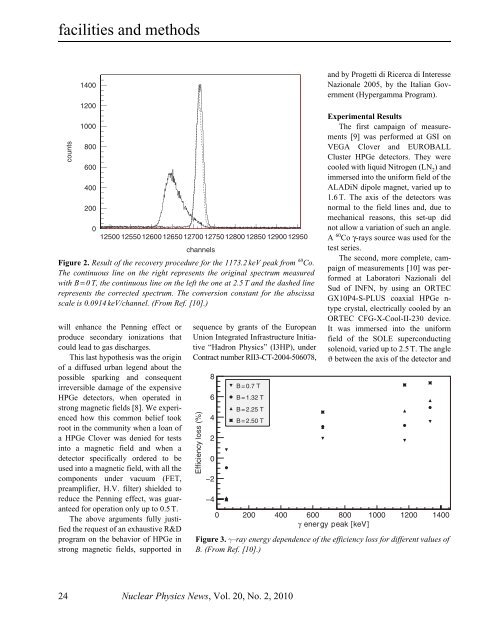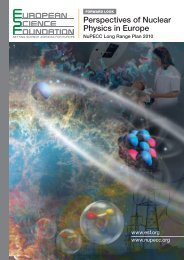facilities and methodscounts14001<strong>20</strong>01000800600400<strong>20</strong>0012500 12550 12600 12650 12700 12750 12800 12850 12900 12950will enhance the Penning effect orproduce secondary ionizations thatcould lead to gas discharges.This last hypothesis was the originof a diffused urban legend about thepossible sparking and consequentirreversible damage of the expensiveHPGe detectors, when operated instrong magnetic fields [8]. We experiencedhow this common belief tookroot in the community when a loan ofa HPGe Clover was denied for testsinto a magnetic field and when adetector specifically ordered to beused into a magnetic field, with all thecomponents under vacuum (FET,preamplifier, H.V. filter) shielded toreduce the Penning effect, was guaranteedfor operation only up to 0.5 T.The above arguments fully justifiedthe request of an exhaustive R&Dprogram on the behavior of HPGe instrong magnetic fields, supported inchannelsFigure 2. Result of the recovery procedure for the 1173.2 keV peak from 60 Co.The continuous line on the right represents the original spectrum measuredwith B = 0 T, the continuous line on the left the one at 2.5 T and the dashed linerepresents the corrected spectrum. The conversion constant for the abscissascale is 0.0914 keV/channel. (From Ref. [10].)sequence by grants of the EuropeanUnion Integrated Infrastructure Initiative“Hadron Physics” (I3HP), underContract number RII3-CT-<strong>20</strong>04-506078,Efficiency loss (%)864<strong>20</strong>−2−4B = 0.7 TB = 1.32 TB = 2.25 TB = 2.50 Tand by Progetti di Ricerca di InteresseNazionale <strong>20</strong>05, by the Italian Government(Hypergamma Program).Experimental ResultsThe first campaign of measurements[9] was performed at GSI onVEGA Clover and EUROBALLCluster HPGe detectors. They werecooled with liquid Nitrogen (LN 2 ) andimmersed into the uniform field of theALADiN dipole magnet, varied up to1.6 T. The axis of the detectors wasnormal to the field lines and, due tomechanical reasons, this set-up didnot allow a variation of such an angle.A 60 Co γ-rays source was used for thetest series.The second, more complete, campaignof measurements [10] was performedat Laboratori Nazionali delSud of INFN, by using an ORTECGX10P4-S-PLUS coaxial HPGe n-type crystal, electrically cooled by anORTEC CFG-X-Cool-II-230 device.It was immersed into the uniformfield of the SOLE superconductingsolenoid, varied up to 2.5 T. The angleϑ between the axis of the detector and0 <strong>20</strong>0 400 600 800 1000 1<strong>20</strong>0 1400γ energy peak [keV]Figure 3. g–ray energy dependence of the efficiency loss for different values ofB. (From Ref. [10].)24 Nuclear Physics News, <strong>Vol</strong>. <strong>20</strong>, <strong>No</strong>. 2, <strong>20</strong>10
facilities and methodsFigure 4. Correlation between the energy in channels and the rise time for the1.332 MeV g-rays from 60 Co at different values of B. The lines represent theparabolic fit functions for each distribution. The conversion constant for theordinate scale is 0.63 keV/channel. (From Ref. [9].)the field direction could be variedbetween 0° and 40°. γ-ray sources of241 Am, 137 Cs, and 60 Co were used,allowing a scan over the γ-rays energyfrom 59.5 to 1332.5 keV.Finally, a very systematic study ofthe possible variation in time of the relevantparameters (resolution, efficiency,skewness of the peak) was performed atPolitecnico di Torino, on an EURISYScoaxial HPGe n-type, LN 2 cooled,immersed into a 0.8T uniform magneticfield normal to the crystal axis [11].Data were taken with seven differentγ-rays sources, allowing a fine scan overthe photon energy up 1332.5keV. Measurementslasted several months.Figure 1 summarizes in a compactway the different conditions underwhich the various measurements wereperformed.We do not report here more detailson the measurements and on the dataanalysis, which can be found in theoriginal papers, and we focus attentiononly on the more relevant conclusionsthat can be drawn.The first, important result is thatHPGe detectors may be used withoutharm for their integrity (no sparks)when immersed into magnetic fields upto 2.5T. We verified as well that thereare no damages or degradation of theperformances for continuous operationlasting months. Significant deformationsof the spectra were observed, asexpected, with a non-simple pattern.Figure 2 shows the spectra relative tothe 1173.2keV γ-ray line from 60 Co atB=0 and 2.5T, taken at ϑ=0°. A shift ofthe centroid of the peak by about 8keVtoward lower energies was observedwith an increase of the FWHM of abouta factor 3; in addition, a strong asymmetryis evident, indicated by the pressenceof a tail at high energies. Similar distortionswere observed at lower values ofB, different photon energies, and differentvalues of J.A clear common trend was the shift ofthe peak toward lower energies with anincrease of its FWHM, whereas the asymmetryshowed a non-intuitive pattern. AtJ=90° an opposite shape was observed [9]with a tail at low energies. At J=25° thepeak was nearly symmetric.The asymmetric peaks could be wellfitted to bi-Gaussian functions [12] withfour free parameters. As a result wefound that all the fitted parameters werefollowing nicely straight lines as a functionof the photon energy, with slopesdepending on the B intensity.This parameterization reproducedvery well the shift of the centroid of thepeak, its FWHM and also the asymmetry,described by the skewness of thecurve, measured experimentally [10].A quantity that did not show aregular behavior was the efficiencyloss of the detector, defined experimentallyas the difference betweenN1 and N2, where N1 and N2 are theγ-peak contents without and withmagnetic field, normalized to N1.Figure 3 shows the measured values.Quite surprisingly we measurednegative values (i.e., an increase ofthe efficiency) for low energy γ-raysand at high values of B. In any case itis clear that the energy loss does notexceed 8% for any B value tested.<strong>Vol</strong>. <strong>20</strong>, <strong>No</strong>. 2, <strong>20</strong>10, Nuclear Physics News 25
















